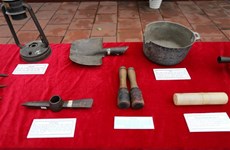Clever growers switch to bonsai kumquat trees
With Tet just around the corner, Tu Lien village in Tay Ho district,
Hanoi, has seen many customers come looking for kumquat trees.
With Tet just around the corner, Tu Lien village in Tay Ho district,
Hanoi, has seen many customers come looking for kumquat trees.
This year, buyers are particularly interested in bonsai kumquats as alternatives to traditional kumquats. While bonsai kumquats yield 50 percent more profits, they require a lot of hard work and meticulous attention to grow.
The Manh, owner of a 3,600sq.m kumquat garden, used to grow traditional kumquat trees. However, he switched to the other variety in 2004 after noticing that customers usually preferred the bonsai types, which are smaller and grown in miniature clay pots.
He didn't succeed with his first try and the majority of his bonsai couldn't survive. After a lot of trial and error, he learned that careful preparation and planning were fundamental in growing bonsai kumquats.
Manh uses a mix of riverside earth, fertiliser and a few other materials that must be rich yet soft enough for the trees to grow. It must be further enriched in a garden for another year before it can be used.
The trees must be fed fertiliser and soybeans every 15-20 days in addition to being watered every day. Weaker trees require even more care, according to Manh.
This year, he successfully grew almost 400.
"Keeping them alive is just the first step. Growing them in the desired shape is the true test of a gardener's skill and patience," said Nguyen Xuan Loc, who has over 700 bonsai kumquats in his field.
Small metal strings are used to shape the trees, but applying too much force can break the trees, while keeping the metal strings on for too long can ruin their shape. This process takes up to a year. Then the trees can be sold.
"It's a delicate balance to maintain but it will come with experience. The worst part is that even if you did everything right, it only counts for 10 percent. The rest is up to the weather," he said, explaining that too much sun or rain could also kill the trees.
When it does pay off, it's good money. The price varies from 700,000 VND (33 USD) to 30 million VND (1,400 USD) but most are sold for about 2 million VND (100 USD). Some rare trees are not available for sale but can be rented for a short while.
Both gardeners said business has been good this year, as they had sold 70-80 percent of their trees.
President of Tu Lien's Farmers Association Ngo Thi Nga said that roughly 400 households in the village are growing kumquat trees but only about 20 knew how to grow the bonsai types.
The association is planning to create a coop group to help disseminate useful information and provide support for gardeners looking to switch to growing bonsai kumquats.-VNA
This year, buyers are particularly interested in bonsai kumquats as alternatives to traditional kumquats. While bonsai kumquats yield 50 percent more profits, they require a lot of hard work and meticulous attention to grow.
The Manh, owner of a 3,600sq.m kumquat garden, used to grow traditional kumquat trees. However, he switched to the other variety in 2004 after noticing that customers usually preferred the bonsai types, which are smaller and grown in miniature clay pots.
He didn't succeed with his first try and the majority of his bonsai couldn't survive. After a lot of trial and error, he learned that careful preparation and planning were fundamental in growing bonsai kumquats.
Manh uses a mix of riverside earth, fertiliser and a few other materials that must be rich yet soft enough for the trees to grow. It must be further enriched in a garden for another year before it can be used.
The trees must be fed fertiliser and soybeans every 15-20 days in addition to being watered every day. Weaker trees require even more care, according to Manh.
This year, he successfully grew almost 400.
"Keeping them alive is just the first step. Growing them in the desired shape is the true test of a gardener's skill and patience," said Nguyen Xuan Loc, who has over 700 bonsai kumquats in his field.
Small metal strings are used to shape the trees, but applying too much force can break the trees, while keeping the metal strings on for too long can ruin their shape. This process takes up to a year. Then the trees can be sold.
"It's a delicate balance to maintain but it will come with experience. The worst part is that even if you did everything right, it only counts for 10 percent. The rest is up to the weather," he said, explaining that too much sun or rain could also kill the trees.
When it does pay off, it's good money. The price varies from 700,000 VND (33 USD) to 30 million VND (1,400 USD) but most are sold for about 2 million VND (100 USD). Some rare trees are not available for sale but can be rented for a short while.
Both gardeners said business has been good this year, as they had sold 70-80 percent of their trees.
President of Tu Lien's Farmers Association Ngo Thi Nga said that roughly 400 households in the village are growing kumquat trees but only about 20 knew how to grow the bonsai types.
The association is planning to create a coop group to help disseminate useful information and provide support for gardeners looking to switch to growing bonsai kumquats.-VNA













